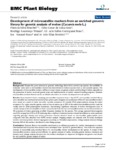Por favor, use este identificador para citar o enlazar este ítem:
http://www.alice.cnptia.embrapa.br/alice/handle/doc/957237| Título: | Development of microsatellite markers from an enriched genomic library for genetic analysis of melon (Cucumis melo L.) |
| Autor: | RITSCHEL, P. S.  LINS, T. C. de L.   LOURENCO, R. L.   BUSO, G. S. C.   BUSO, J. A.   FERREIRA, M. E.   |
| Afiliación: | PATRICIA SILVA RITSCHEL, CNPUV; TULIO CESAR DE LIMA LINS, CPAC; ISABELA TRISTAN LOURENCO, CENARGEN; GLAUCIA SALLES CORTOPASSI BUSO, CENARGEN; JOSE AMAURI BUSO, SRI; MARCIO ELIAS FERREIRA, CENARGEN. |
| Año: | 2004 |
| Referencia: | BMC Plant Biology, London, v. 4, n. 1, p. 9-24, 2004. |
| Páginas: | 16 p. |
| Descripción: | Background: Despite the great advances in genomic technology observed in several crop species, the availability of molecular tools such as microsatellite markers has been limited in melon (Cucumis melo L.) and cucurbit species. The development of microsatellite markers will have a major impact on genetic analysis and breeding of melon, especially on the generation of marker saturated genetic maps and implementation of marker assisted breeding programs. Genomic microsatellite enriched libraries can be an efficient alternative for marker development in such species. Results: Seven hundred clones containing microsatellite sequences from a Tsp-AG/TC microsatellite enriched library were identified and one-hundred and forty-four primer pairs designed and synthesized. When 67 microsatellite markers were tested on a panel of melon and other cucurbit accessions, 65 revealed DNA polymorphisms among the melon accessions. For some cucurbit species, such as Cucumis sativus, up to 50% of the melon microsatellite markers could be readily used for DNA polymophism assessment, representing a significant reduction of marker development costs. A random sample of 25 microsatellite markers was extracted from the new microsatellite marker set and characterized on 40 accessions of melon, generating an allelic frequency database for the species. The average expected heterozygosity was 0.52, varying from 0.45 to 0.70, indicating that a small set of selected markers should be sufficient to solve questions egarding genotype identity and variety protection. Genetic distances based on microsatellite polymorphism were congruent with data obtained from RAPD marker analysis. Mapping analysis was initiated with 55 newly developed markers and most primers showed segregation according to Mendelian expectations. Linkage analysis detected linkage between 56% of the markers, distributed in nine linkage groups. Conclusions: Genomic library microsatellite enrichment is an efficient procedure for marker development in melon. One-hundred and forty-four new markers were developed from Tsp-AG/TC genomic library. This is the first reported attempt of successfully using enriched library for microsatellite marker development in the species. A sample of the microsatellite markers tested proved efficient for genetic analysis of melon, including genetic distance estimates and identity tests. Linkage analysis indicated that the markers developed are dispersed throughout the genome and should be very useful for genetic analysis of melon. |
| Thesagro: | Melão Genética |
| Palabras clave: | Análise genética Marcador microsatélite Melhoramento genético |
| Tipo de Material: | Artigo de periódico |
| Acceso: | openAccess |
| Aparece en las colecciones: | Artigo em periódico indexado (CNPUV)  |
Ficheros en este ítem:
| Fichero | Descripción | Tamaño | Formato | |
|---|---|---|---|---|
| RITSCHELBMCPlantBiolv4p12004.pdf | 437,47 kB | Adobe PDF |  Visualizar/Abrir |









